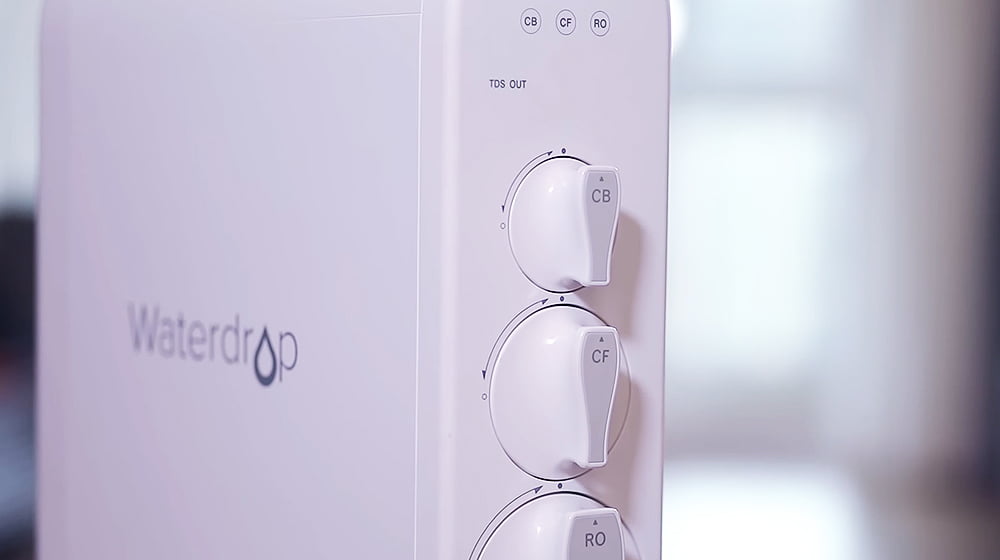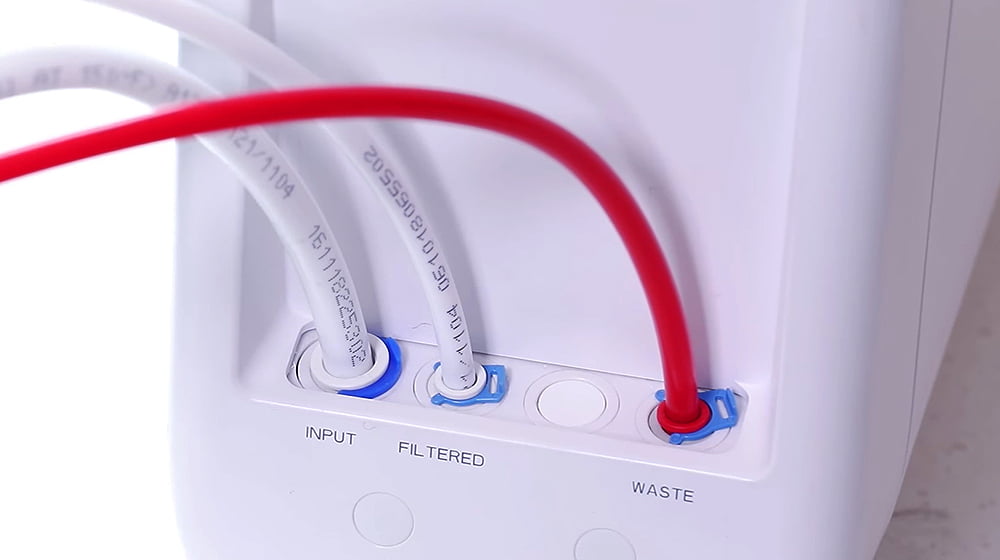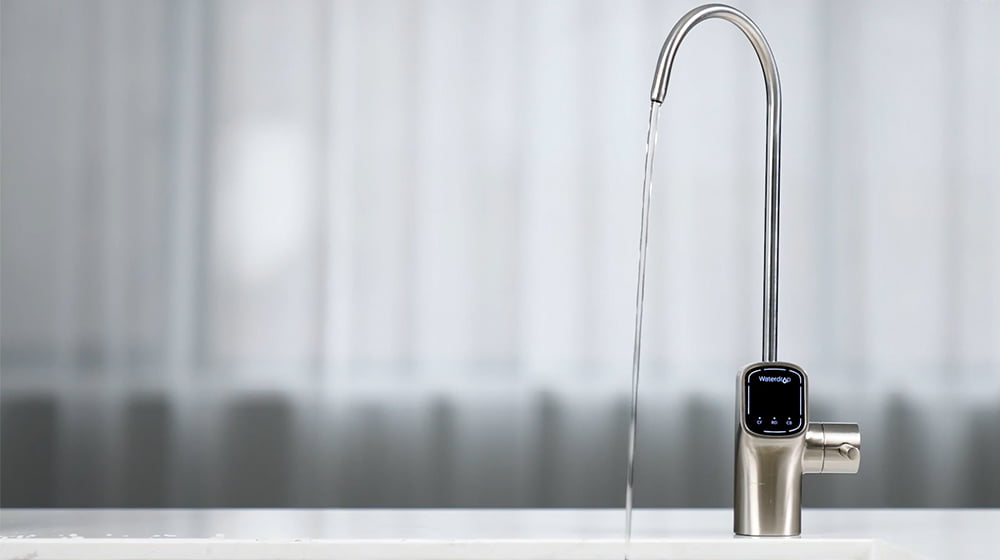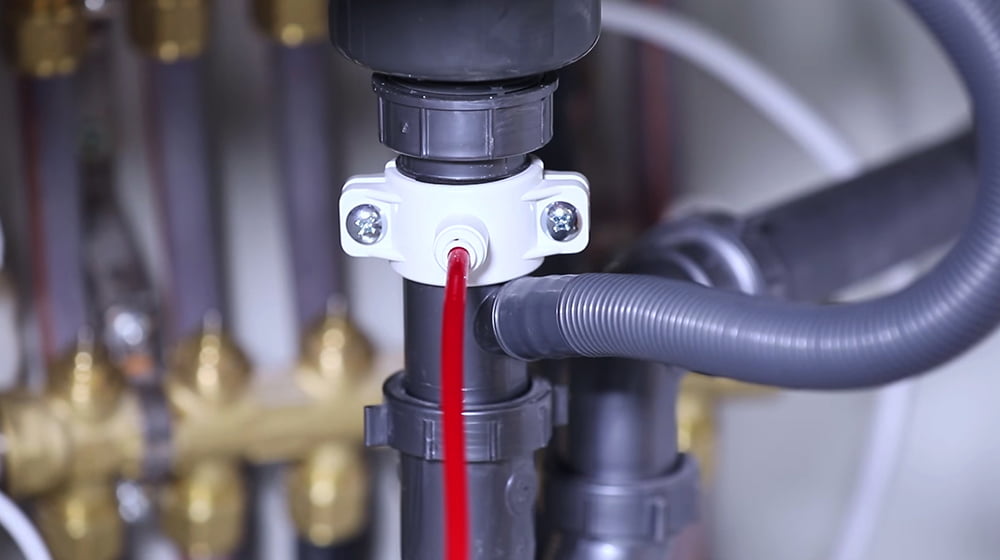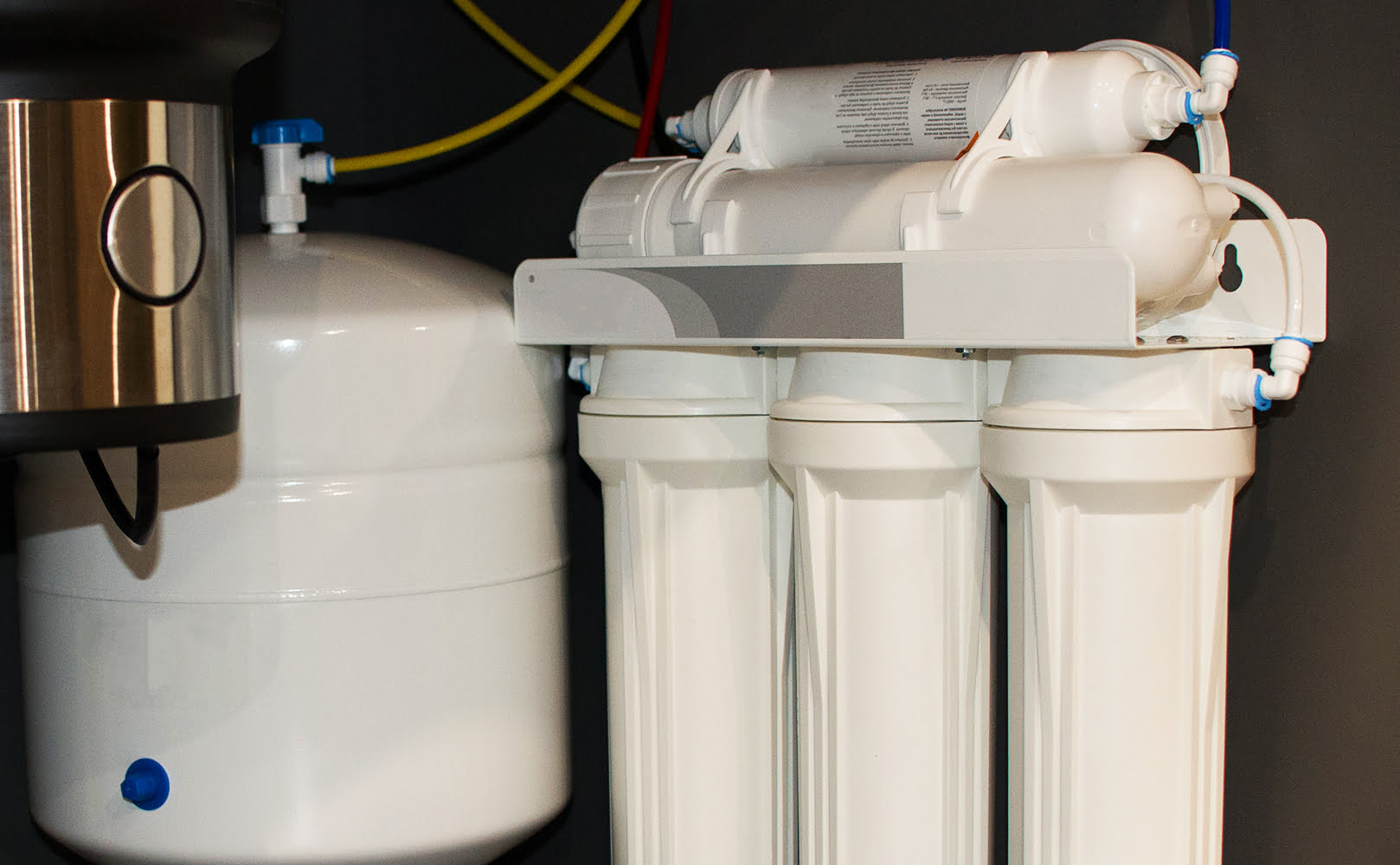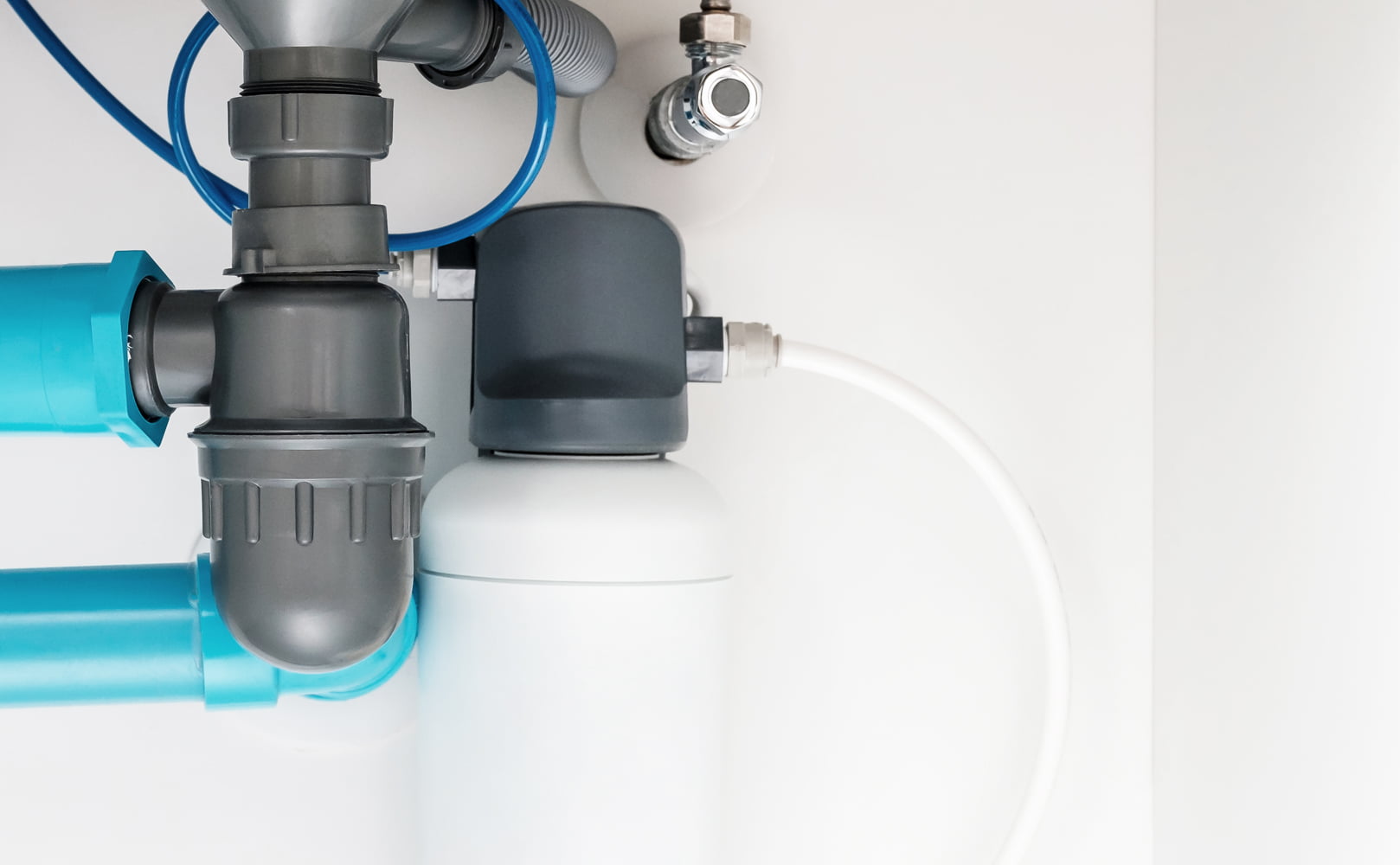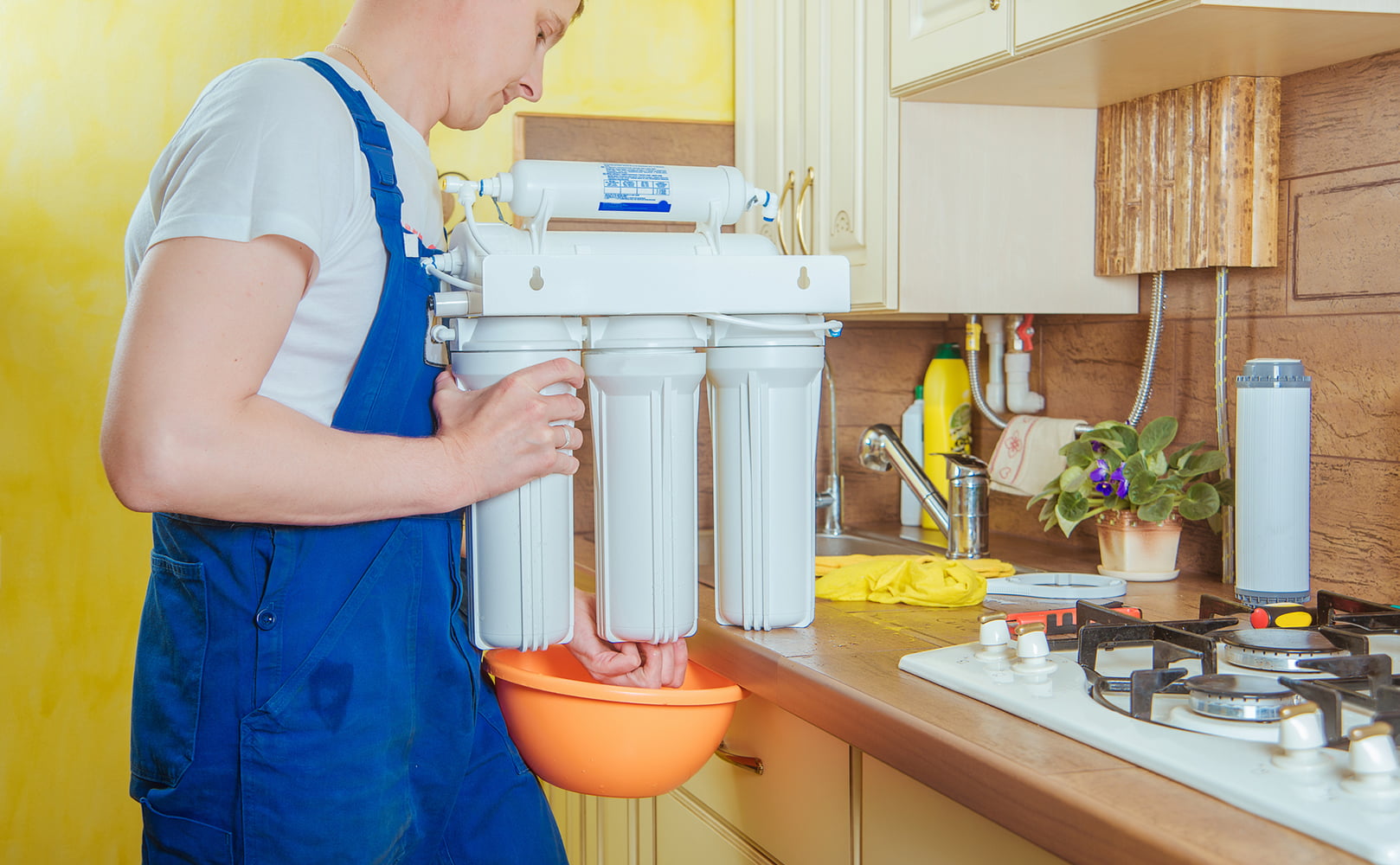3 Best Under Sink Water Filters for Hard Water (*Update 2024)
Written by: Alexandra Uta // Expert Fact-Checking: Buddhini Dolapihilla, MBSS // Last Updated: Jan 31, 2024
This page may contain affiliate links. If you buy a product or service through such a link we earn a commission at no extra cost to you. Learn more.
Top Pick: What’s the Best Under Sink Water Filter for Hard Water?
The best under sink water filter for hard water in 2024 is the Waterdrop G3, because it is highly effective at making hard water soft, NSF-certified for contaminant reduction, easy to install and maintain, backed by a 30-day satisfaction guarantee and 1-year warranty, and it has a long filter life of 550 to 2,000 gallons.
When it comes to dealing with hard water, finding the right under sink filter isn’t always easy. Well, we’ll help you make an informed decision and choose the ideal model for you – from all the different options available.
We’ve reviewed over 28 under sink water filters and identified those specifically suited for hard water. We’ve tested, compared, and ranked them as part of this buying guide to bring you the latest and most reliable information. Let’s go!
No Time to Read? Check Our List of the Best Under Sink Water Filters for Hard Water!
| Product | Details | |
|---|---|---|
 Best Overall: Waterdrop G3 Tankless Under Sink Reverse Osmosis System |
Overall Rating: 4.0/5.0 ⓘRatings based on effectiveness of hardness reduction and contaminant removal, NSF standards, filter life, costs, our testing, user ratings, product warranty/support, and other factors.
Get 10% Off! Use Code: |
Price: $$$ Filter Type: Tankless RO Filter Life: 550-2,200 gal NSF: 58, 372 Annual Cost: ~$145 Read Review: Click Alexa’s Video Review: Click |
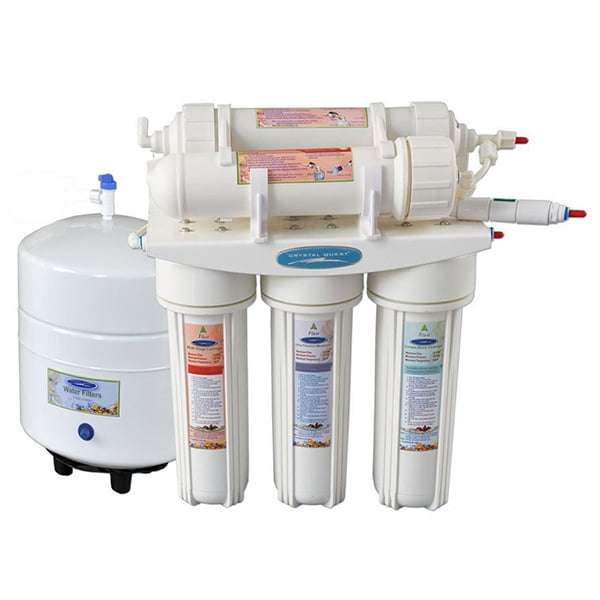 Best for Hard Well Water: Crystal Quest 1000C |
Overall Rating: 4.5/5.0 ⓘRatings based on effectiveness of hardness reduction and contaminant removal, NSF standards, filter life, costs, our testing, user ratings, product warranty/support, and other factors.
Get 5% Off! Use Code: |
Price: $$ Filter Type: RO + Ion Exchange Filter Life: 1-3 Years NSF: – Annual Cost: ~$100-155 Read Review: Click |
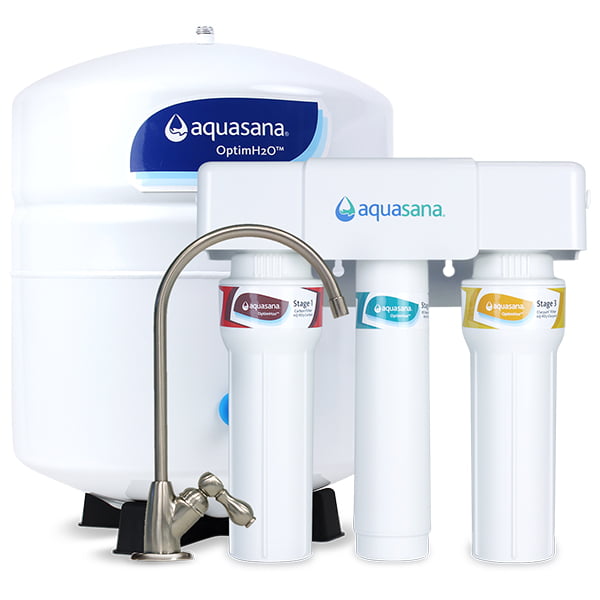 Best NSF-Certified: Aquasana OptimH2O Under Sink RO System |
Overall Rating: 4.5/5.0 ⓘRatings based on effectiveness of hardness reduction and contaminant removal, NSF standards, filter life, costs, our testing, user ratings, product warranty/support, and other factors.
|
Price: $$ Filter Type: RO Filter Life: 365 gal NSF: 42, 53, 58, 401 Annual Cost: ~$240 Read Review: Click |
Under Sink Hard Water Filter Reviews
Our Top Picks
- Waterdrop G3 – Best Overall
- Crystal Quest 1000C – Best for Hard Well Water
- Aquasana OptimH2O – Best for NSF-Certified Contaminant Reduction + Remineralization
1. Best Overall: Waterdrop G3 Tankless Under Sink Reverse Osmosis System
In our opinion, the best under sink water filter for hard water in 2024 is the Waterdrop G3. That’s because the system is based on reverse osmosis which is incredibly effective at eliminating not only water hardness but also any other impurities in your water (including harmful ones). Besides, it’s a tankless unit that is easy to install and fast.

Waterdrop G3 Tankless Under Sink Reverse Osmosis System |
|
| Price: | $$$ |
| Type: | Tankless Reverse Osmosis |
| Filtration Capacity: | 550-2,200 Gallons |
| NSF Standards: | 58, 372 |
| Annually: | ~$145 |
|
Overall Rating: 4.0/5.0 ⓘRatings based on effectiveness of hardness reduction and contaminant removal, NSF standards, filter life, costs, our testing, user ratings, product warranty/support, and other factors.
Get 10% Off! Use Code: |
|
Alexa’s Video Review
Being part of the BOS team, Alexa has ordered and tested the Waterdrop G3 Reverse Osmosis System, which means she has installed the system with her own hands and used it for several weeks for some genuine first-hand experience! Alexa has documented the entire process, including her findings and personal verdict, in the video provided below:
Other Specs
- Model: G3P600
- Last Price: $539.00
- Filter Media/Process: Sediment, 2x Carbon Block, RO Membrane
- Filter Stages: 4
- Flow Rate: 0.42 gpm
- Membrane Rating: 600 gpd
- Recovery Rate: 66%
- WxHxD: 5.67″x17.72″x18.12″
- Weight: 32.4 lb.
- Water Temperature: 41-100 °F
- Water Pressure: 14.5-87 psi
- Warranty: 1 Year
Key Features & Pros
- Four-stage filter system removes a wide array of contaminants including water hardness.
- The first 2 stages are a composite carbon/sediment filter that remove both chlorine and sediment so it can’t damage the RO membrane. Activated carbon also takes care of organic chemicals including pesticides.
- The next stage is the RO membrane which removes a wide array of contaminants including heavy metals, salts, and any hardness minerals.
- Lastly, an activated carbon block post-filter removes any leftover pollutants and ‘polishes’ the water’s taste.
- Reverse osmosis is highly effective at removing nearly all water hard water minerals including the two most common: Calcium and magnesium.
- The system is NSF-certified to Standard 58 for the reduction of total dissolved solids, as well as Standard 372 for lead-free construction materials.
- The built-in pressure pump increases system pressure resulting in a flow rate of 0.42 gallons per minute. While this is not high when compared with non-RO under sink water filters, it’s very impressive for an RO system.
- The under sink filter will fill a standard-sized cup in approximately 8 seconds.
- The pressure pump also helps to reduce the amount of wastewater generated to a respectable 0.67 gallons for each gallon of filtered water created.
- The system only uses BPA-free materials.
- The tankless design avoids the possibility of secondary microbial infection and frees up significant under sink space.
- The smart display faucet shows real-time TDS readings as well as indicators for your remaining filter lifespan. You can find the same indicators on the unit itself.
- Installation is quite simple and can be performed by most people with some prior DIY experience. You just need the right tools.
- Maintenance is very simple and replacing filters takes seconds thanks to the twist design.
- Annual maintenance costs come to approximately $145 – which is very reasonable for a system of this type.
- Systems come with a 30-day money-back satisfaction guarantee, so you can return for a full refund for any reason.
- 1-year manufacturer warranty.
Cons
- While it sports several interesting and unique features, the Waterdrop G3 nonetheless costs more than most other under sink hard water filters.
- Some users have run into issues with the included TDS meter displaying higher TDS levels at first. This may be related to TDS creep – which is an increase in TDS levels after a period of leaving the RO membrane idle.
- Another thing to consider is that while RO membranes are highly effective at removing hardness minerals, they can clog prematurely when used consistently with very hard water. This can lead to more frequent RO membrane replacements.
Our Rating
- Filtration Performance: 4.0/5.0
- Filter Life: 5.0/5.0
- Price: 3.5/5.0
- Maintenance Cost: 4.0/5.0
- Overall: 4.0/5.0
Best for
Overall, the Waterdrop G3 is the best option for an under sink hard water filter, while also offering thorough contaminant removal and a tankless design.
2. Best for Hard Well Water: Crystal Quest 1000C & 1000CP Under Sink Water Filters
If you are on hard well water, we recommend the Crystal Quest 1000C or 1000 CP under sink water filter. They both combine reverse osmosis, which for itself is highly effective at reducing water hardness, with ion exchange which is the same time-proven filtration method we also find in water softeners. Besides, the ion exchange resin comes before the RO membrane protecting said membrane from scaling!
By the way, the difference between the Crystal Quest 1000C and the Crystal Quest 1000CP is that the latter uses a pressure pump in order to boost filtration speed and reduce wastewater.
Other Specs
- Model: 1000C
- Last Price: $298.40
- Filter Media: 5-Micron Carbon Block, UF Membrane, GAC, Ion Exchange Resin, KDF, RO, GAC, Sediment Filter Pads
- Filter Stages: 12
- Flow Rate: 0.03 gpm
- Membrane Rating: 50 gpd
- WxHxD: 16″x21″x8″
- Tank: 11″x15″x11″, 3.2 gal
- Water Temperature: 40-85 °F
- Operating Pressure: 30-60 psi
- Warranty: 1 Year
Key Features & Pros
- An impressive 12 filter stages provide extremely thorough contaminant filtration which includes an ion exchange filter stage to reduce water hardness specifically.
- Stage 1: A 5-micron activated carbon block adsorbs chlorine, VOCs, pesticides, and herbicides, as well as removing sediment, sand, and silt from fouling the later filter stages.
- Stage 2: Water then passes through a 0.02-micron ultrafiltration membrane to remove microbial contaminants, colloids, proteins, and many other tiny particles.
- Stage 4: GAC (granular activated carbon) removes over 99% of chlorine odor and taste as well as further reducing contaminants like VOCs, pesticides/herbicides, PCBs, THMs, and more.
- Stage 5: This is the ion exchange stage which reduces water hardness as well as certain heavy metals.
- Stages 6 & 7: These stages are a combination of 2 KDF media types. They remove sulfur, iron, mercury, chromium 6 (all common well water contaminants), and other heavy metals, as well as stopping bacterial growth.
- Stage 9: This is the RO membrane stage. It removes nearly all particles down to .0001 microns. This also includes any remaining hard water minerals.
- Stage 11: A final GAC filter stage removes any residual poor tastes or odors.
- Stages 3, 8, 10, and 12 are all filter pads designed to reduce/remove suspended particulates.
- The combination of ion exchange filtration and reverse osmosis is highly effective at removing water hardness, including the common hardness-causing minerals magnesium and calcium.
- 50-gallon per day capacity (theoretical) is enough to filter water for larger families.
- Installation is no more difficult than with other under sink RO water filter systems.
- Maintenance requirements are low for such a complex system.
- Subscribing to the manufacturer’s auto-ship will save you 5% on replacement filters.
- Limited one-year manufacturer warranty.
Cons
- No NSF testing or certifications mean we have no way of verifying the manufacturer’s claims.
- Installation instructions could be more detailed.
- The system will not work as intended if the iron content is more than 2 ppm or if the water hardness is above 15 grains per gallon.
Our Rating
- Filtration Performance: 4.0/5.0
- Filter Life: 5.0/5.0
- Price: 5.0/5.0
- Maintenance Cost: 4.5/5.0
- Overall: 4.5/5.0
Best for
The Crystal Quest 1000C & 1000CP systems are ideal for under sink filtration for hard well water.
3. Best NSF-Certified + Remineralization: Aquasana OptimH2O Under Sink Reverse Osmosis Water Filter System
We’ve added the Aquasana OptimH2O to our list of best under sink hard water filters for 3 reasons:
- It eliminates water hardness effectively.
- It is NSF-certified for removing a wide range of harmful water contaminants.
- It integrates remineralization so that after filtration there still are healthy levels of minerals left in your drinking water.

Aquasana OptimH2O Under Sink Reverse Osmosis Water Filter System |
|
| Price: | $$ |
| Type: | Reverse Osmosis |
| Filtration Capacity: | 365 Gallons |
| NSF Standards: | 42, 53, 58, 401 |
| Annually: | ~$240 |
|
Overall Rating: 4.5/5.0 ⓘRatings based on effectiveness of hardness reduction and contaminant removal, NSF standards, filter life, costs, our testing, user ratings, product warranty/support, and other factors.
|
|
Other Specs
- Model: OptimH2O
- Filter Media: Activated Carbon, RO Membrane, Activated + Catalytic Carbon + Ion Exchange Resin, Remineralization
- Filter Stages: 4
- Membrane Rating: 35 gpd
- Recovery Rate: 29.43%
- WxHxD (System): 12″x12.5″x4.5″
- Tank: 11″x16″x11″, 3.2 gal
- Water Temperature: 40-100 °F
- Operating Pressure: 40-100 psi
- Warranty: 2 Years
Key Features & Pros
- Four-stage filter system removes a wide array of impurities including water hardness.
- Stage 1: Activated carbon media removes both chlorine taste and odor as well as particulates – both of which can prematurely damage the RO membrane.
- Stage 2: The reverse osmosis membrane removes heavy metals, nitrites/nitrates, microbial contaminants, water hardness minerals, and more.
- Stage 3: Next, a combination of both activated carbon and catalytic carbon + ion exchange resin removes chlorine/chloramine, pesticides/herbicides, VOCs, and disinfectant by-products among other chemicals.
- Stage 4: Lastly, a remineralization stage adds back some essential minerals also in order to balance water pH.
- The system features NSF testing and certifications for Standards 42, 53, 58, 401, and Protocol P473. These include testing results for the removal of 99% of lead, 97% of chromium 6, 97.6% of arsenic, 95.7% of fluoride, 99.99% of cysts, 99.99 of asbestos, and 96% of chlorine/chloramine, pesticides, and herbicides.
- Three dedicated faucet designs are available: Chrome, Brushed Nickel, and Oil Rubber Bronze.
- You can also use your existing air gap faucet if you wish.
- Installation is straightforward and can be performed on your own without the need for a plumber.
- Detailed installation instructions come included with the purchase.
- All components needed for installation are included.
- Maintenance requirements are also fairly low.
- The system comes with a 90-day money-back satisfaction guarantee in case you’re unhappy for any reason.
- A 2-year manufacturer warranty on the entire system is included.
Cons
- Annual filter replacement costs will come in at around $240 which is fairly expensive.
- Subscribing to the manufacturer’s auto-ship program will save you 15% on replacements and give you access to an extended warranty.
- Some users had issues with unexpected leaking and poor overall system quality.
- As the system doesn’t feature a pressure pump, it will generate a relatively high level of wastewater when compared to pumped systems. No pump also means slower flow rate.
- As with other RO systems used to remove water hardness, excessively high levels of water hardness will lead to premature fouling and more frequent RO membrane replacements.
Our Rating
- Filtration Performance: 5.0/5.0
- Filter Life: 4.5/5.0
- Price: 4.0/5.0
- Maintenance Cost: 4.0/5.0
- Overall: 4.5/5.0
Best for
Overall, the Aquasana OptimH2O under sink filter system is the best for reducing water hardness combined with NSF-tested and certified contaminant reduction + remineralization.
→ Full Aquasana OptimH2O RO System Review
- We’ve Found and Listed the Best Under Sink Water Filters
- Under Sink Well Water Filters – Our Recommendations
- These Are the Best Under Sink Hot and Cold Water Filters
- Whole House Hard Water Filter Reviews
- Best Under Sink Water Filters for Apartments
- List with All Under Sink Water Filters Featured on BOS
Comparison List
(Mobile Hint: Swipe to Scroll)
| Model | Price | Type | Filter Process | Filter Stages | Membrane Rating | Filtration Capacity | NSF Standards | Annually | Warranty | Additional Info |
|---|---|---|---|---|---|---|---|---|---|---|
| Waterdrop G3 | $$$ | Tankless Reverse Osmosis | Sediment, Carbon Blocks, RO | 4 | 600 gpd | 550-2,200 Gallons | 58, 372 | ~$145 | 1 Year | |
| Crystal Quest 1000C | $$ | Reverse Osmosis + Ion Exchange | Carbon Block, Ultrafiltration, Granular Activated Carbon, Ion Exchange, KDF, RO, Sediment Filtration | 12 | 50 gpd | 1-3 Years | – | ~$100-155 | 1 Year | |
| Aquasana OptimH2O | $$ | Reverse Osmosis | Activated Carbon, RO Membrane, Activated + Catalytic Carbon + Ion Exchange Resin, Remineralization | 4 | 35 gpd | 365 Gallons | 42, 53, 58, 401 | ~$240 | 2 Years |
Buying Guide: How to Choose the Under Sink Hard Water Filter That’s Best for You
The following are key features worth considering when shopping for an under sink hard water filter. They will help you choose the right one for your needs and budget.
Water Hardness Level
The first step necessary before purchasing any under sink water filter is testing your water. In the case of water hardness, this is very easy to test using a simple home test strip that measures the concentration of calcium carbonate in your water.
Very high levels of water hardness are difficult to deal with using under sink systems, so if that is what you discover you may need to look into a whole house water softener.
Type and Quality of Water Source
Your type of water source will also have an impact on the type of filter system you’ll need. Generally speaking, well water tends to contain higher levels of contaminants such as sediments, iron, and manganese. With municipal water, on the other hand, you might be facing lead, disinfection byproducts, or industrial solvents, etc.
So, it makes sense to conduct further testing to determine which other impurities/contaminants your water contains. For well water, this means either using a home test kit or sending in a sample for professional testing. Home test kits are cheap and offer instant results, but are less accurate than professional testing.
If your water is municipally sourced, then you can consult several publicly available resources like the EWG Tap Water Database. The database is a collection of all recent Consumer Confidence Reports (water quality reports) that must be provided by public water utilities. You can also access the reports here. The purpose of finding this contaminant data is to help you pick out a system that will not only reduce water hardness but also eliminate other problematic contaminants you may be dealing with. Of course, you can also conduct your own testing even when on a public water supply. Just know that it’s not cheap.
Under Sink Hard Water Filter Type
When it comes to under sink hard water filter systems, there are only two types to consider: Reverse osmosis, and ion exchange.
- Reverse osmosis systems remove hardness-causing minerals via the ultra-fine reverse osmosis membrane. While RO membranes are perfectly capable of removing hardness minerals, they aren’t the ideal solution for this, as excessive hardness minerals will cause the membrane to prematurely clog and require more frequent replacement – increasing the overall maintenance costs.
- Ion exchange filters remove hardness-causing mineral ions like magnesium and calcium by replacing them with softer ions. This is an effective method of reducing water hardness, but when deployed in an under sink system it has one major drawback: Under sink ion exchange filters are much smaller than whole house systems and cannot flush themselves or regenerate. This means they will reach the end of their lives quickly and will need frequent replacement – especially in the case of very hard water.
As you can see, neither of the above options is ideal when dealing with high levels of water hardness under your sink, which is why a full-sized water softener is the better choice when dealing with very hard water.
Water Flow Rate
Water flow rate refers to the total capacity of a system to filter water at once. It is typically measured in gallons per minute (gpm) and will give you an idea of the speed at which your system can filter and dispense water from a faucet.
Now, all of the under sink filters reviewed above use their own dedicated faucet, which means slow flow is less of an issue. Still, a typical kitchen faucet without any filter will dispense water at about 2 gallons per minute. Between 1 and 2 gpm, you’re unlikely to notice much reduction in water pressure from your faucet. Below 1 gpm you’ll notice significant flow reduction, which can be an issue if you have high water usage. So this is something to keep in mind in case you’re purchasing an under sink filter that connects directly to your existing kitchen faucet.
NSF Testing/Certifications
NSF testing and certifications are the only surefire way you as a consumer can be certain your water filter will remove what the manufacturer says it will.
When it comes to under sink water filter systems for hard water, there are several NSF standards to be aware of.
- NSF Standard 58: This standard pertains to point-of-use reverse osmosis systems, and includes TDS (total dissolved solids) reduction as well as the reduction of contaminants like arsenic, nitrites/nitrates, cysts, and chromium 6.
- NSF Standard 42: This standard pertains to the removal of ‘aesthetic effects’ from water. This includes things like chlorine/chloramine, foul taste and odor, and particulates.
- NSF Standard 53: This standard refers to the removal of ‘health effects’ from water and includes contaminants with known negative health effects like lead, chromium 6, and VOCs.
- NSF Standard 401: This one is for emerging compounds – think trace pharmaceuticals and several pesticides.
Filter Life
Filter life refers to the total lifespan of a filter cartridge or membrane before it requires replacement.
In the case of the above filter systems, this will be highly dependent on the level of water hardness in the source water. As mentioned previously, both RO membranes and ion exchange filters will not last long in situations with very hard water.
Filter life will also vary based on how much you use your system and the level of other contaminants contained in your water. Also, keep in mind that the manufacturer’s stated filter life is the best-case scenario under ideal conditions, and real-life results tend to be less.
Installation and Maintenance
Under sink water filter systems as a rule tend not to be particularly difficult to install and as a result, most can be set up on your own without any special skills or tools.
That said, systems with dedicated faucets tend to be more difficult to hook up than those utilizing your existing faucet, as the former often require drilling a new faucet hole through the countertop or sink.
When it comes to maintenance, most under sink systems are fairly easy to deal with, only requiring periodic filter and membrane changes. Tanked systems will also require periodic cleaning/sanitizing and occasional repressurizing.
Under Sink Space
Under sink cabinet space can be an issue, especially for water filters with storage tanks. An average storage tank measures about 1 cubic foot, so trying to fit one in a smaller under sink cabinet can be tricky.
Cost
Lastly, cost is likely to play a role in your decision making. Luckily, there is a range of price points for under sink hard water filters, so you can generally find one to fit your budget constraints.
When considering costs, it’s important to factor in the annual maintenance cost (filter and membrane replacements), as these can add up quickly. Be sure to consider annual filter replacement costs rather than the cost of individual filters as filters have differing lifespans.
More on Under Sink Water Filters for Hard Water
What Is an Under Sink Water Filter for Hard Water and How Does It Work?
An under sink water filter for hard water is any under sink system capable of removing or reducing water hardness. This usually only includes 2 types: RO systems and ion exchange filters.
Under sink systems are typically installed underneath a kitchen sink and will only filter water supplied to a single faucet.
RO Systems
Reverse osmosis systems utilize an ultra-fine membrane to separate contaminant-filled wastewater from clean filtered water. The wastewater is then flushed down a drain line, while the clean filtered water moves on to the next filtration step.
RO systems, as a function of their filter process, operate slower than other water filter, and as a result, most utilize a storage tank to keep a reserve of water on hand at all times for use.
RO systems are capable of removing an incredibly wide array of impurities and contaminants from water, including hardness-causing minerals like calcium. Unfortunately, this tends to be hard on the membrane, which can lead to premature clogging and more frequent membrane replacements.
Ion Exchange Filters
Ion exchange filters – like their name suggests – use a process known as ion exchange to replace hardness minerals like calcium and magnesium with softer ions (often sodium). The process works through the use of a resin bed supersaturated with sodium. As water flows over the resin, calcium and magnesium bind to the resin beads while sodium ions are released into the water.
This process works well and is typically deployed in larger whole house systems, known as water softeners, capable of flushing and regenerating themselves. Under sink units lack this capability, which is why they often don’t last nearly as long as their whole house counterparts.
Benefits
Scale
The primary benefit of reducing water hardness is the resulting reduction of limescale buildup in your sink. This not only makes the faucet and sink more attractive and easier to use but will save you time and money on maintenance. Additionally, you’ll notice less scale buildup on your dishware.
Healthy Water
While hard water on its own isn’t typically a health concern, an under sink filter system may remove additional contaminants like heavy metals, pesticides/herbicides, chlorine, VOCs, etc.
Better Tasting Water
While there is no inherent harm in consuming water higher in hardness minerals, some people prefer the taste of slightly softer water. Overly hard water tends to have a slightly bitter or metallic/salty taste, while soft water is far more neutral tasting.
Budget Friendly
When compared to expensive whole house water softeners, under sink systems tend to have significantly cheaper up-front costs as well as ongoing maintenance costs.
Installation and Maintenance
Once again, if you compare under sink systems with whole house systems, under sink systems tend to be easy to install and simple to maintain on your own without any professional help.
How to Install & Maintain an Under Sink Filter for Hard Water
Let’s take a quick look at how to install and maintain an under sink hard water filter. While each system is designed slightly differently, the following should give you a general idea of how to install and maintain one.
Installation
When it comes to installation, most under sink systems can be installed in less than an hour without any special tools or skills. Systems with dedicated faucets tend to be slightly more difficult to install, as they often require drilling through the sink or countertop to make a hole for the new faucet.
Installation generally follows these steps:
- Shut off the cold water supply underneath your sink and open the faucet to flush any water remaining in the plumbing lines.
- Now, disconnect the cold water line from the water supply.
- Connect the cold water valve to the inlet on the system.
- Now, run the outlet line from the system to the faucet and turn the cold water supply back on.
- Open the faucet and flush the system as per the manufacturer’s directions.
Keep in mind these are just basic directions, and don’t account for systems with storage tanks or dedicated faucets which require more complex installations. Be sure to consult your installation manual for the specific directions relevant to your system.
Maintenance
When it comes to maintenance, most systems only require periodic replacement of old filter cartridges or membranes with new ones. Systems with storage tanks will also require periodic cleaning/sanitizing of the storage tank.
To maintain an under sink hard water filter:
- Shut off the cold water supply under your sink.
- Open the cold water on the faucet to release any water and stored up pressure in the plumbing lines.
- Remove the filter housing from the unit.
- Remove and dispose of the old cartridge and clean the interior of the housing with warm soapy water.
- Insert a new cartridge into the housing.
- Now is a good time to check on the condition of the O-rings inside the filter housing. If broken or damaged replace them with fresh O-rings.
- Mount the filter housing back to the unit.
- Turn the cold water supply back on.
Challenges When Reducing Water Hardness with Under Sink Filters
As mentioned previously, there are several issues with reducing water hardness using under sink filters.
RO systems can get the job done, but as RO membranes aren’t designed to deal with very hard water, they can become prematurely clogged in this scenario. Likewise, ion exchange systems will reach the end of their useful lives quickly in situations with very hard water.
One potential solution to this issue is utilizing both RO and ion exchange together to extend the lifespan of both filters. The other one would require installing a standard water softener capable of flushing and regenerating its resin bed.
Frequently Asked Questions (FAQ)
- Do under sink hard water filters actually work?
Yes, they do. You just need to choose the right type of system, so either cation exchange or reverse osmosis. Both are highly effective at removing hard water minerals. A reverse osmosis membrane eliminates water hardness by rejecting calcium, magnesium, etc. Cation exchange resin binds said minerals and releases softer ones like sodium into the water. - What kind of under sink filter is best for hard water?
The best kind of under sink water filter for hard water is one that uses a reverse osmosis membrane and/or cation exchange resin. - Is it safe to drink hard tap water?
Yes, drinking hard water in general is perfectly safe unless the hardness level is very extreme which usually doesn’t happen. Hard water is simply water that contains higher levels of minerals like calcium and magnesium. These minerals are healthy and add to your daily nutritional intake. - What are the cons of under sink water filters when filtering hard water?
There are 2 major cons: When using an under sink reverse osmosis system to filter hard water, the RO membrane is prone to scaling which can reduce water flow considerably. The only remedy here is replacing membranes more frequently which adds to the cost. When using an ion exchange water filter to eliminate very hard water, the resin may soon loose its ability to bind more hardness minerals rendering it ineffective. Again, the only remedy is to replace the filter element more often.
How We Chose and Tested the Best Under Sink Water Filters for Hard Water (Why Trust Us)
We followed a strict methodology to review our under sink water filters for hard water. Here’s an overview of the process:
- Establishing Criteria: First, we developed a list of 19 attributes to evaluate all the filters against.
- Initial Selection: We then compiled a list of over 28 under sink water filters.
- Thorough Evaluation: We thoroughly examined product manuals, descriptions, warranties, and third-party certifications/test data based on standards established by the NSF. This helped us to narrow down our list to those under sink filters that can handle hard water well.
- Additionally, we conducted interviews with representatives from 3 well-known brands (Aquasana, Waterdrop, Crystal Quest) to assess their level of support. At this point we had 5 systems left.
- User Feedback Analysis: To ensure that only high-quality filters made it to our final selection, we carefully analyzed feedback and third-party ratings from real users on various platforms. We took extra precautions to filter out any fake or unreliable reviews. Products left: 3.
- Hands-On Testing: We purchased and installed 2 of the systems onto a suitable hard water supply, allowing us to gain firsthand experience. We paid attention to factors such as ease of installation and maintenance, filter size, and the hardness level and pressure of the filtered water. We ensured that both filters operated for a minimum of 3 weeks.
- Lab Testing: To further validate our findings, we conducted independent lab testing. This allowed us to assess real-life contaminant reduction rates.
- Finally, it was time to present all information in a buying guide that would be easy to use. We made sure to structure our findings in a pros vs cons format.
Please note that all the information and ratings provided are impartial and unbiased. Our content is also subject to professional fact-checking to ensure accuracy. For one, we had the assistance of Buddhini Dolapihilla, MBSS, in evaluating contamination reduction claims and NSF certifications.
About Our Ratings
Our evaluation process for under sink water filters for hard water primarily focuses on the following key factors: Hardness + contaminant reduction rates based on NSF testing (30%), price and annual cost (25%), 1st hand testing and user feedback (20%), filter capacity (15%), customer service and product warranty (10%).
We’ve rated each filter on a score of 1 to 5, with 5 being the highest rating.
Questions? Ask away!
Information provided on BOS is for educational purposes only. The products and services we review may not be right for your individual circumstances.
We adhere to strict editorial guidelines. Rest assured, the opinions expressed have not been provided, reviewed, or otherwise endorsed by our partners – they are unbiased, independent, and the author’s alone. Our licensed experts fact-check all content for accuracy. It is accurate as of the date posted and to the best of our knowledge.

